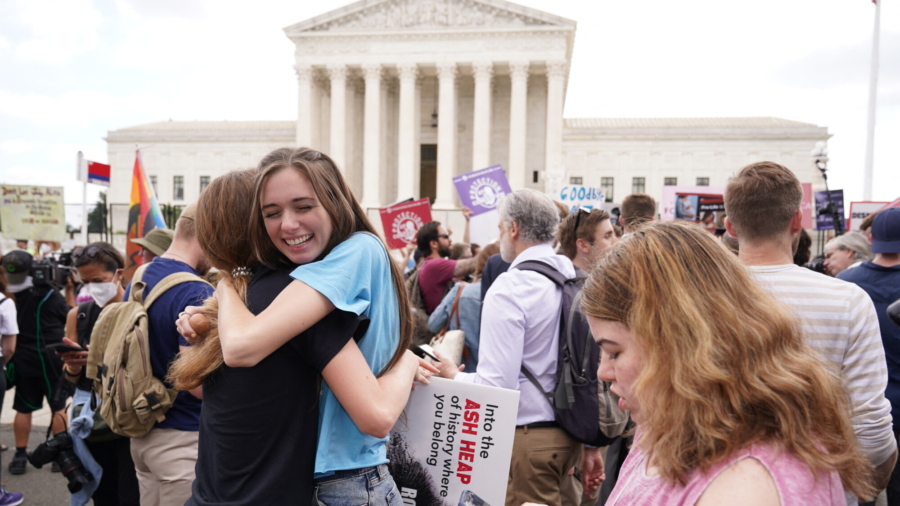The Supreme Court on June 24 overturned Roe v. Wade, the seminal 1973 precedent that largely legalized abortion in the United States.
The court, in a 6–3 ruling powered by its conservative majority, upheld a Mississippi law that bans abortion after 15 weeks of pregnancy and to overturn Roe. Chief Justice John Roberts concurred with the court’s conservatives, but argued that he would have upheld the Mississippi law without taking the additional step of erasing the Roe precedent altogether.
The 116-page ruling also reversed the 1992 companion precedent known as Planned Parenthood v. Casey, which held that states can’t impose significant restrictions on abortion before a fetus becomes viable for life outside the womb.
The Casey ruling didn’t specify when viability occurs, but suggested it was somewhere around the 24-week gestation mark.
The June 24 ruling came in Dobbs v. Jackson Women’s Health Organization (court file 19-1392).
In the case, the only state-licensed abortion clinic in Mississippi opposed the state’s Gestational Age Act, which allows abortions after 15 weeks of gestation only for medical emergencies or severe fetal abnormality. Citing Roe, lower courts had held that the state statute was unconstitutional.
Politico published the draft document dated Feb. 10 on May 2 without disclosing its source. The tight-lipped court is investigating the leak, but details of the ongoing probe are few and far between.
Justice Samuel Alito wrote the majority opinion. The three dissenting justices—Stephen Breyer, Sonia Sotomayor, and Elena Kagan—took the unusual step of issuing a three-way joint dissent.
Alito explained in the court’s opinion why the majority believes Roe v. Wade was wrongly decided 49 years ago.
“Abortion presents a profound moral issue on which Americans hold sharply conflicting views,” he wrote.
“Some believe fervently that a human person comes into being at conception and that abortion ends an innocent life. Others feel just as strongly that any regulation of abortion invades a woman’s right to control her own body and prevents women from achieving full equality.
“Still others in a third group think that abortion should be allowed under some but not all circumstances, and those within this group hold a variety of views about the particular restrictions that should be imposed.”
For the first 185 years after the U.S. Constitution was adopted, “each state was permitted to address this issue in accordance with the views of its citizens,” but then, in 1973, the Supreme Court decided Roe v. Wade. Despite the fact that the Constitution doesn’t mention abortion, the court found that “it confers a broad right to obtain one.”
The court made no claim “that American law or the common law had ever recognized such a right, and its survey of history ranged from the constitutionally irrelevant (e.g., its discussion of abortion in antiquity) to the plainly incorrect (e.g., its assertion that abortion was probably never a crime under the common law),” Alito wrote.
“After cataloging a wealth of other information having no bearing on the meaning of the Constitution, the opinion concluded with a numbered set of rules much like those that might be found in a statute enacted by a legislature.”
The court created a scheme in which “each trimester of pregnancy was regulated differently, but the most critical line was drawn at roughly the end of the second trimester, which, at the time, corresponded to the point at which a fetus was thought to achieve ‘viability,’ i.e., the ability to survive outside the womb.”
Even though the court acknowledged that states “had a legitimate interest in protecting ‘potential life,’” Alito wrote, it determined that this interest didn’t justify imposing any restrictions on abortions in the pre-viability stage.
The court offered no explanation for this finding, which even abortion supporters have been hard-pressed to defend.
Alito noted that one high-profile constitutional scholar, John Hart Ely, wrote that he “would vote for a statute very much like the one the Court ended up drafting” had he been “a legislator,” but in his view, Roe was “not constitutional law” at all “and gave almost no sense of an obligation to try to be.”
Alito pointed to the dissenting opinion of Justice Byron White, who wrote that Roe v. Wade represented the “exercise of raw judicial power.” Alito added that the decision “sparked a national controversy that has embittered our political culture for a half-century.”
In the three-way dissent, Breyer, Kagan, and Sotomayor lambasted the new majority opinion.
“It says that from the very moment of fertilization, a woman has no rights to speak of. A state can force her to bring a pregnancy to term, even at the steepest personal and familial costs,” the justices wrote.
“An abortion restriction, the majority holds, is permissible whenever rational, the lowest level of scrutiny known to the law.
“And because, as the court has often stated, protecting fetal life is rational, states will feel free to enact all manner of restrictions.”
Reuters contributed to this report.
From The Epoch Times

